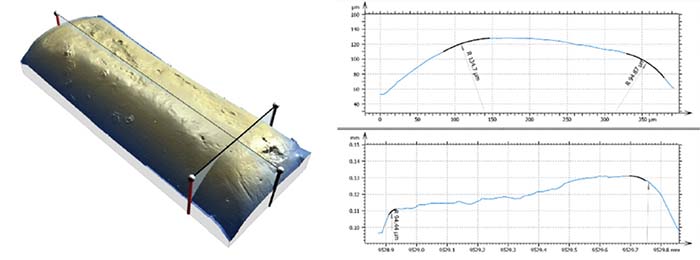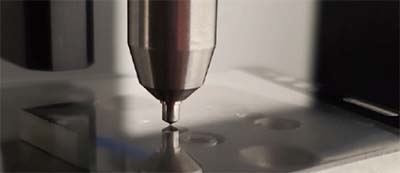Wear Resistance Of Screen Protectors Introduction
As ubiquitous as the smartphones are the screen protectors that are sold to protect their screens. These screen protectors are most of the time made from tempered glass with a polymer backing. But when searching for one of those screen protectors, the question always arises: which one is better?
All the products claim the same hardness and high wear resistance. But are all these tempered glass products truly similar in terms of wear?
The main cause of scratches or wear are metallic objects such as keys and dust including sand particles (quartz) that damage those screen protectors the most.
Need help or have a question?
Wear Resistance of Screen Protector Test Problematic

Figure 1: Key damage on screen protector
Wear Resistance Methodology
Asperity characterization:
The first step was the characterization of the key asperity to pick the right equivalent radius. This was achieved using the Rtec-Instruments Lambda head profilometer to image 3 different teeth of a key and measuring the radii at the different edges (Figure 2).
Wear Measurement:
To simulate the different asperities in contact with the screen protectors, diamond tips of different radii are dragged repeatedly along the surface of the samples to create a wear track following ASTM G133. A constant normal force is applied to the tip to simulate the force of an asperity sliding on the screen protector surface. The full wear track is imaged as constant interval to observe its evolution and quantify the wear as a function of time. The test is stopped when complete chipping failure along the wear track is observed. Multiple signals can be recorded during the scratch test, allowing the user to correlate behaviors and specific measures.

Figure 2: Key Tooth Profilometry
Wear Resistance Testing Conditions
The Lambda head profilometer was used to image the key teeth. A confocal image using a 50X magnification objective was obtained and further analyzed to determine the average asperity radius to be used in the wear test.
The Indentation Scratch Tester (SMT-5000) was used to create wear tracks (Figure 3) on three different tempered glass screen protectors. A simple reciprocating linear wear test was performed on the different samples. Two different diamonds were used to simulate sand (20 microns radius) and a key (100 microns radius). The normal forces on the diamonds were also chosen to mimic the real-life situations.
A Confocal image of the full track was taken after every 300 cycles. Finally, the wear volume was measured after 1500 cycles to compare the different samples.
The test parameters are summarized in Table 1
| Load Application Profile | Constant Load |
| Track Length | 1 mm |
| Normal Load | 2 & 7 N |
| Linear Reciprocating Frequency | 5 Hz |
| Stylus | Diamond spheres 20 µm & 100 µm radius |
Table 1: Test Conditions
Figure 3: Screen protector with diamond stylus in the SMT-5000
Screen Protector Wear Resistance Test Results
Asperity Radius Characterization
Three teeth of a key were imaged to be representative of different angles and radii. Each tooth was cross sectioned in two orthogonal directions as shown on Figure 4. The average of all radii measured on the key was calculated to be 102.7 microns, yielding the use of a 100 microns radius diamond stylus to perform the wear test.

Figure 4: 3D images of a key tooth and the radii measurements on its cross profiles
Wear Study of Wear Resistance Samples
The linear reciprocating tests lead to three phases of wear on the samples. The first stage is the creation of a groove in the material this occurs within the first few hundred cycles. The next stage is the apparition of Hertzian cracks either in the wear track or at one of the ends of the track. Finally, the cracks propagate and leads to complete failure of the glass by chipping.
The number of cycles necessary to observe this complete failure of the screen protector was recorded for each sample and compared to quantify the resistance of each of the products.
The results are shown in Table 3.
Wear Volume (µm3)
| 20 µm stylus | 100 µm stylus | |
|---|---|---|
| A | 2789 | 5116 |
| B | 5674 | 8992 |
| C | 4851 | 6497 |
Table 2: Wear track volume for the different samples

Figure 5: Wear track on Sample A after 300 cycles
Figure 6: Volume Wear
After 1000 cycles, the continuous application of the load in the wear groove starts to create Hertzian cracks in the tempered glass as shown in both confocal and bright field images. The dark field image confirms the presence of crack as indicated on Figure 7.
Starting with the first cracks, some glass particles enter the sliding contact and accelerate the degradation of the groove. Although the apparition of first cracks would incite the user to change its screen protector, this study pushed the linear reciprocating test to the point of chipping the tempered glass to compare the ultimate limit on each sample. Figure 8 shows such failure in the middle of the wear track.

Figure 7: Hertzian cracks on sample B
(confocal image on top and bright field at the bottom)
Starting with the first cracks, some glass particles enter the sliding contact and accelerate the degradation of the groove.
Although the apparition of first cracks would incite the user to change its screen protector, this study pushed the linear reciprocating test to the point of chipping the tempered glass to compare the ultimate limit on each sample. Figure 8 shows such failure in the middle of the wear track.
The number of cycles necessary to observe this complete failure of the screen protector was recorded for each sample and compared to quantify the resistance of each of the products.
The results are shown in Table 3.
Figure 9 summarizes this study illustrating both the wear volume and cycle to complete failure for each sample.
# of cycles required for complete failure
| 20 µm stylus | 100 µm stylus | |
|---|---|---|
| A | 3900 | 4500 |
| B | 1800 | 2100 |
| C | 3300 | 3900 |
Table 3: Cycles to complete failure of samples

Figure 8: Chipping failure of the tempered glass on the wear track for sample C

Conclusions
Previous application notes focused on the scratch resistance of screen, glasses (screen cover) for the smartphone applications (See Rtec Instruments application notes on Scratch Resistance of Glass). The same instruments can bring a deeper understanding of glasses by providing a full tribology study as demonstrated above. The ASTM G133 or other relevant standards can be run on the Rtec-Instruments to further the understanding of such glasses and their protection ability for the smartphone they are supposed to protect.
The automatic image acquisition at different intervals provides a unique visualization of the wear track and different failures. The confocal images allow for volume and area calculations therefore simplifying the tribology analysis of such study.
Although those three different screen protectors claimed similar performances, this study showed a clear difference in wear resistance and fracture resistance for these samples.
The Scratch and Indentation Tester Has More To Offer
Learn more about our Indentation and Scratch Tester, the SMT-5000.
Need Versatile Scratch and Indentation Testing?
Take a look at the Multi Function Tribometer, the MFT-5000.
Want to learn more?
Get in touch, and request a demo.
recommended
Information
© Copyright 2021 Rtec-Instruments - All Rights Reserved





